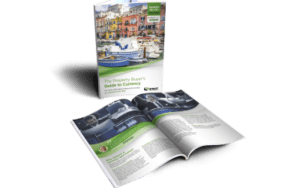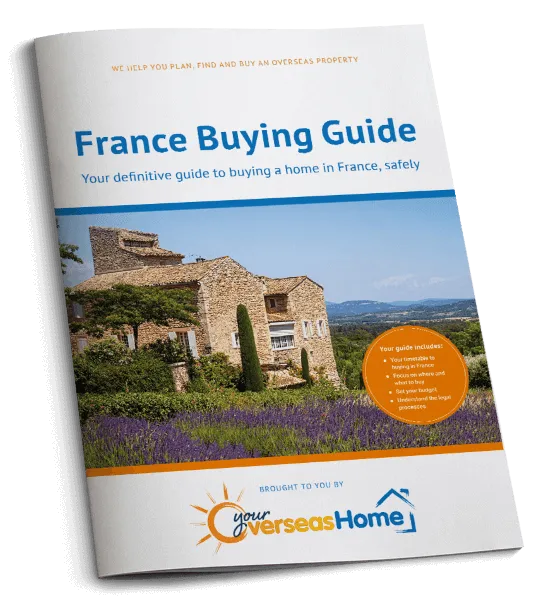With the 2024 Paris Olympics confirmed and President Macron bringing a new optimism to the City of Lights, we investigate the Paris property market. What is happening to prices, where will the Olympic effect be felt, and how is the city’s new mayor taking liveability to the heart of its future plans.
Find homes in France via our property portal.
There’s a wave of optimism sweeping the French capital and it’s easy to see why. With the Olympics coming to the city in 2024, could it repeat the success, and the profits for property investors, that London saw in the 11 years between being awarded the Olympics in 2005 and the Brexit vote last year? Here we sift the evidence.
Now France has another opportunity to prosper, and at the expense of its old adversary, as the ‘Brexit effect’ kicks in.
Macron + Brexit = ?
Newly-elected President, Emmanuel Macron isn’t messing around. In his first few months in office we’ve seen President Putin at Versailles and Trump at Bastille Day. Macron has been compared to the only man younger than him to have been President, Napoleon, and Macron seems to have a similar opinion. He is a man on a mission to transform France back into the global power it once was. Already, the French jobs market has sprung to life and property prices and sales are rising across France too. That all began in the days of President Macron’s predecessor, the “hapless” Hollande, but why let that get in the way of a good story!
Now France has another opportunity to prosper, and at the expense of its old adversary, as the ‘Brexit effect’ kicks in. Uncertainty surrounding Brexit is enticing UK buyers while some global firms and EU agencies are setting their sights on Paris. If you buy in France in the 20 months or so before the UK leaves the European Union, you may be well on the way to maintaining some of your EU rights, which for many seems preferable to going through the rigmarole of securing a French visa. And it isn’t just UK buyers turning to Paris. For more than 300,000 French people living in London and many more elsewhere in the UK, Paris is coming back on to the radar. Most analysts would agree that the previous administration was not business-friendly, forcing entrepreneurial French people to move abroad – to London, New York, Canada etc – to make their way in the world. Many will be looking at Macron and wondering if it might be time to come back, especially as property prices are lower than a few years ago.
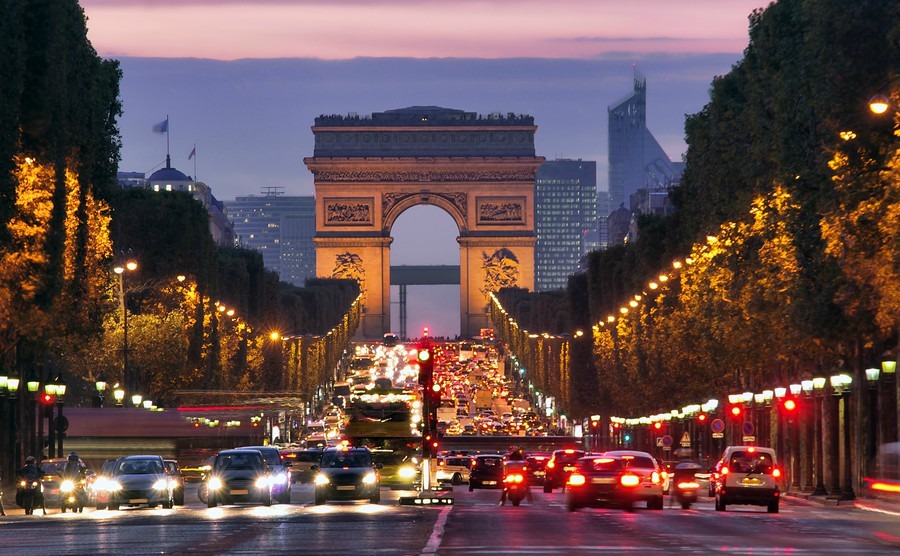
The Champs-Elysees at dusk
A rising market
Since 2016 there has been an influx of buyers to Paris. Even with the coinciding devaluation of sterling, prices in the city remain lower than in London. Flats in some of the most upmarket enclaves in Paris remain just over half the price of their London equivalent. Prices have increased by 6% in the city over the course of 2016 and transaction volumes have reached levels not seen in more than a decade. It’s possible to secure historically low mortgage rates of less than 2% and if Paris follows in the footsteps of London post-Olympics, property prices could double over the course of the next decade.
This chart shows the average price of property per square metre in each of Paris’s 20 arrondissements as of July 2017. It also shows the percentage increase in price since this time in 2016.
| Arrondissement | Price/m2 (€) | Year growth | Arrondissement | Price/m2 (€) | Year growth |
| 1st | 8,794 | +7.5% | 11th | 8,423 | +3.6% |
| 2nd | 9,780 | +6.7% | 12th | 7,940 | +6.8% |
| 3rd | 9,940 | +2.4% | 13th | 7,561 | +4.1% |
| 4th | 10,891 | +10% | 14th | 8,893 | +6.6% |
| 5th | 10,479 | +5.5% | 15th | 8,568 | +4.8% |
| 6th | 12,796 | +2.1% | 16th | 10,228 | +2.3% |
| 7th | 11,730 | +2.4% | 17th | 9,221 | +9.0% |
| 8th | 10,553 | +5.7% | 18th | 8,193 | +9.0% |
| 9th | 9,128 | +7.4% | 19th | 6,979 | +4.9% |
| 10th | 8,048 | +8.2% | 20th | 7,021 | +7.3% |
A more liveable Paris
There’s already much to desire about life in Paris but there are exciting plans afoot to transform the city into a well-connected, eco-friendly, 21st century metropolis. The most noteworthy plan involves the creation of ‘Grand Paris’, an idea originally introduced by Sarkozy to unite central Paris with the suburbs outside of the Le Périphérique ring-road. By bringing these surrounding areas under a single mayor and council, as with Greater London, the city will become more connected, more economically competitive, and development and infrastructure will improve.
There are plans to pedestrianise historic parts of the city and from 2018 a tram bus will operate along the right bank of the Seine.
Commitment to the Paris Convention on climate change is evident in all the city’s plans and Anne Hidalgo, Paris’s first female mayor, is making big strides to reduce the city’s carbon footprint and to improve air quality. In 2016, Hidalgo introduced her ‘Paris Respire’ scheme, banning all cars from central areas, and making electric car and bike schemes free on the first Sunday of the month. Free parking has been abolished on allocated days, and the price of parking on a meter has been increased in a bid to encourage folk to use other forms of transport. Several of the highway sections along the Seine have been converted into a riverside park and Hidalgo has proposed a total ban on diesel motors in Paris.

Paris is a wonderful city in which to grow up
She’s not stopping there. 2017 is the ‘Year of the Bicycle’, and by 2020 the mayor has vowed to double the length of the city’s bike lanes and halve motor traffic. There are plans to pedestrianise historic parts of the city around the Marais and along the Rue de Rivoli and from 2018 a tram bus will operate along the right bank of the Seine.
The Olympic effect
Paris has won the 2024 Olympics. Following disappointment at the loss to London in 2012, many Parisians watched with envy as London became me of the two or three most important global cities. There were unflattering comparisons between London’s upgraded infrastructure and Paris’s creaking facilities.
So will Paris2024 do for the city what London2012 achieved? Paris’s plans include €3billion being plied into improving transport and infrastructure. Investors will take notice, more trade deals will be struck, tourism will go through the roof and property prices will rise further. The Games is also likely to create around 190,000 jobs, all enriching the city’s coffers.
The 2024 games will be the first to align with the Paris agreement, with sustainability at the heart of all plans. Paris has pledged to reduce the carbon footprint of the games by 55%. Although the majority (70%) of the sites to be used for the games already exist, although many will undergo renovations. The Olympic Village will be 100% sustainable, swimming areas will be created in the Seine, and bicycle lanes will be doubled, and more. A brand new indoor arena is to be built in the Bercy neighbourhood in the 12th arrondissement.
The areas around Saint-Denis, La Courneuve and Le Bourget are ones to watch. There is a lot of exciting development happening and investors are already taking notice
The Olympic and Paralympic villages, and a new aquatics centre, will be located seven kilometres to north of the city in Saint-Denis, less than five minutes from the Stade de France. The areas around Saint-Denis, La Courneuve and Le Bourget are ones to watch. There is a lot of exciting development happening in the area in the next few years and investors are already taking notice. You can read more about the city’s plans and the locations of developments and events at the Paris2024 website.
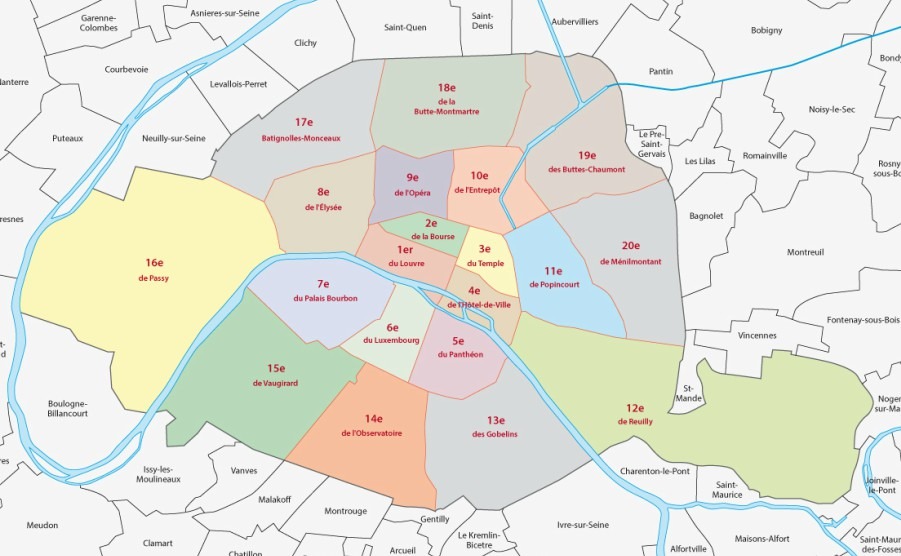
Paris’s administrative areas, arrondissements
Major development projects
The Grand Paris Express, an expansion of the city’s Métro system which will add four lines and 68 stations, is a major part of the Grand Paris plan, and has been dubbed ‘the most ambitious subway project in the Western World’. When complete, usage of the Métro is expected to increase by 40%. New routes will unite the centre of Paris with its suburbs, and reduce journey times between key areas. More opportunities will be created for developers, investors and corporate occupiers and we can expect to see modern, eco-friendly neighbourhoods and business hubs developing in previously overlooked locations.
.
Developers are already setting their sights on the small towns beyond Le Périphérique, like La Courneuve (close to Saint-Denis) and Villejuif (to the south). La Défénse, a once dreary area called home by the city’s exiled high-rise office buildings, is currently undergoing a major revamp to transform it into a green quarter. Directly under the Grande Arche you can see from central Paris there will be a garden, restaurants, bars and shops. The Garden of the Arche, due to be completed this year, will see La Défense’s first new housing units in 30 years. There will also be a hotel, business school, 40,000sqm of office and commercial space, a leisure centre and the largest indoor concert hall in Europe. La Groues is another 76-hectare industrial site adjacent to La Défense, also set to benefit from the arrival of the Métro. This development is due to be completed between 2020-2030 and will create up to 5000 homes.
Last year, Mayor Hidalgo also announced the winners of the Reinventing Paris competition, which will see 22 pre-existing sites around the capital be repurposed, some into housing. The Pershing Village in the 17th is an inverted pyramid structure created for developers, investors and corporate occupiers and we can expect to see modern, eco-friendly neighbourhoods and business hubs developing in previously overlooked locations.
Find homes in France via our property portal.
Developers are already setting their sights on the small towns beyond Le Périphérique, like La Courneuve (close to Saint-Denis) and Villejuif (to the south). La Défénse, a once dreary area called home by the city’s exiled high-rise office buildings, is currently undergoing a major revamp to transform it into a green quarter. Directly under the Grande Arche you can see from central Paris there will be a garden, restaurants, bars and shops. The Garden of the Arche, due to be completed this year, will see La Défense’s first new housing units in 30 years. There will also be a hotel, business school, 40,000sqm of office and commercial space, a leisure centre and the largest indoor concert hall in Europe. La Groues is another 76-hectare industrial site adjacent to La Défense, also set to benefit from the arrival of the Métro. This development is due to be completed between 2020-2030 and will create up to 5000 homes.
Last year, Mayor Hidalgo also announced the winners of the Reinventing Paris competition, which will see 22 pre-existing sites around the capital be repurposed, some into housing. The Pershing Village in the 17th is an inverted pyramid structure that will feature private and social housing hidden within a forest of trees. The Castagnary Bathhouse in the 15th is to be transformed into shared housing and an artist collective.
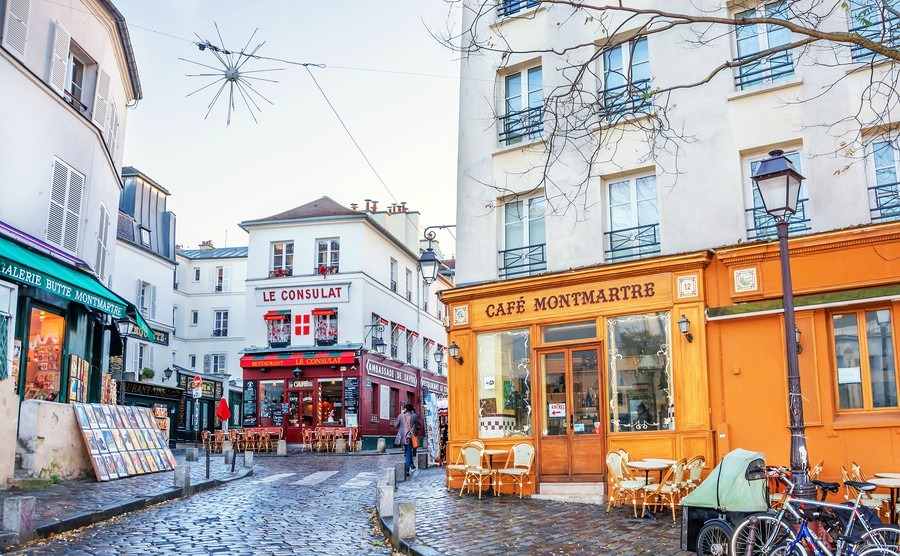
When the tourists go home – Montmartre in winter (MarinaDa / Shutterstock.com)
Where to buy?
If you’re ready to buy in Paris, download the French Buying Guide to see the processes and costs involved. You will also need to speak to a currency expert to get a definite idea of your euro budget and when might be the best time to change your currency. We recommend Smart Currency Exchange as they are experts in property and the most trusted company or currency exchange and money transfer as voted by Trust Pilot users.
With that done, where should you buy? Of course, that depends on what you’re looking for, so here we offer a few suggestions.
Best for Art Lovers (and big budgets!) – 6th Arrondissement
If you dream of sipping coffee beside Paris’s arty community, you’ll like the 6th. The Left Bank, “La Rive Gauche”, on the south side of the Seine, is home to the French School of Fine Arts, and many prestigious galleries. Foreign buyers love this area – it’s the iconic Paris seen in the movies, and the area around Place Saint Germain-des- Prés was once frequented by the likes of Oscar Wilde, Jean-Paul Satre and Simone de Beauvoir. If you have a sizeable budget for your Paris pied-à-terre properties around Luxembourg Gardens and along the quais (the river) are some of the most extravagant in town. Prices will depend upon each specific building and in some instances you can expect to pay €18,000-25,000 per square metre (psm), but you might still get something for €10,000psm if you’re lucky.
Best for living like a Parisian – 9th
If you want to live like a local, opt for their favourite arrondissement, the 9th. Here you’ll find an excellent blend of street shopping, nightlife, theatre, affordable restaurants and fresh food markets. South Pigalle (SoPi), around Martyrs-St Georges, is the city’s hippest, most liveable spot. Apartments are around 50-80sqm and are the most expensive in the arrondissement. For a larger (more affordable) family apartment, look to the Grand Boulevards around La-Fayette-Châteaudun, Rue Amsterdam and Rue Clichy. Prices range from €6,500 to €12,000 per square metre, depending on area.
Best for investors – 10th
Brits seeking convenient pied-á-terres flock to this area as it’s home to the Gare du Nord and Gare de l’Est train stations. This traditionally working-class neighbourhood has typically Parisian style apartments and more modern units, including old factories repurposed into apartments. This is one of the most sought-after areas of the city but property is currently very reasonably priced, although this will change in the coming years as the area continues to gentrify. Areas around Canal Saint Martin and Place de la République are considered the best spots, so prices are already creeping up. Look to La Villette and Rue Saint-Denis for the bargains.
Best for low budgets – 12th
The 12th is one of the most affordable options in the city, and its safe reputation and two major Metro lines mean it’s popular with families and native Parisians. Properties on Avenue Daumesnil and Viaduct des Arts are highly sought after, causing purchase prices and rent to soar in recent years. More affordable options are found around Marché d’Aligre, Bercy Park, Le Square Trousseau and Gare de Lyon. Prices range from €5,750 to €10,750 per square metre.
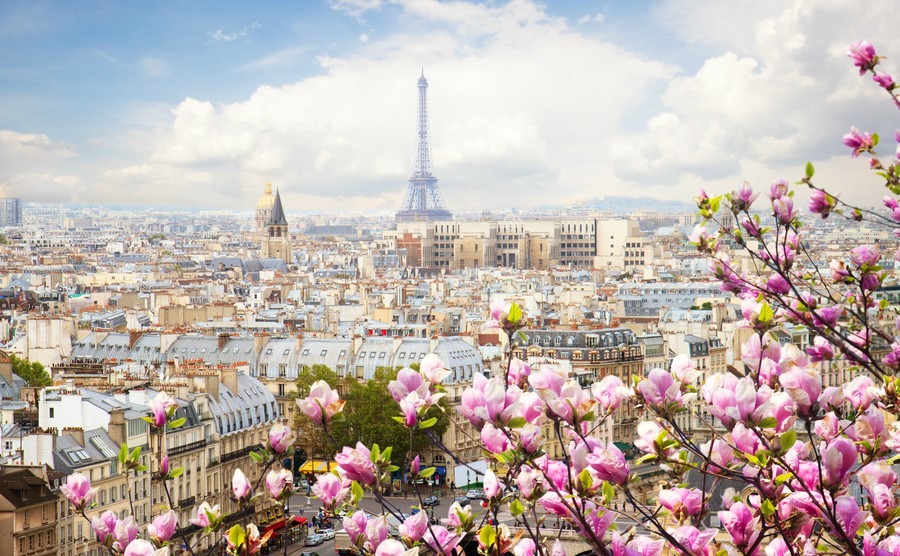
Paris in springtime, with the Eiffel Tower
Best for families – 14th
The 14th is home to charming neighbourhoods populated by Parisian families, seeking a calmer way of life without having to sacrifice urban comforts. The area around Parc Montsouris is particularly charming, with cobblestone streets, single-family homes and relative peace and quiet compared to other areas. Port-Royal, where the 14th borders the 6th, is perfect for people who want an address close to Jardin du Luxembourg and Saint Germain-des-Près without the jaw-dropping price tag. The Montparnasse neighbourhood is affordable but the biggest bargains are found around Métro Plaisance and Boulevard Périphérique. Prices range from €6,000 to €12,000 per square metre.
Best for a village vibe – 17th
For cheaper options offering easy access to the Champ-Élysées and Parc Monceau, head to the Batignolles area. There’s a more traditionally Parisian vibe in this corner of the 17th, with great restaurants, independent boutiques and organic markets on Saturday mornings, and most foreign buyers are yet to catch on. Épinettes and Batignolles are popular with first-time buyers. Those with a higher income look to Place Saint Ferdinand and Place des Ternes. Serious bargains can be found in La Fourche. Again, prices range from below €6,000 to above €12,000 per square metre.
Best for shopping – 18th
Many Brits dream of life in Montmartre and we don’t blame them. The Sacré Coeur is around the corner, as is the Moulin Rouge cabaret, all set in romantic tree-lined streets. You’ll find the city’s best flea markets, and unusual one-off shops around Avenue Junot and Rue Caulaincourt. If you want something with a view, expect to pay 1st arrondissement prices but around the Metro Guy Môquet, you’ll find an area coming to life with shops and bakeries, and price tags that wont give you a heart attack. Prices re fractionally cheaper, starting at around €5,000 per square metre.
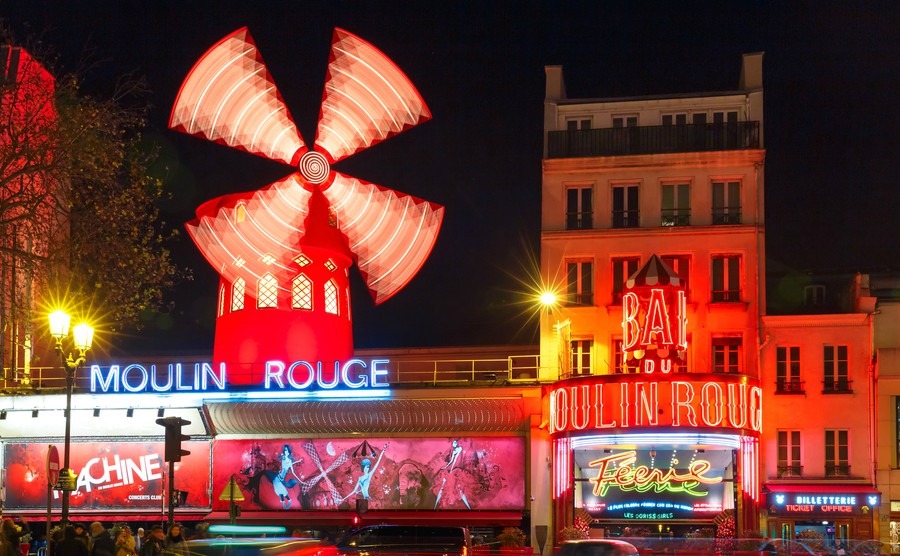
City of Lights (kavalenkava / Shutterstock.com)
Best for bohemians – 20th
The 20th is a socially-diverse neighbourhood undergoing a rapid transition to one of the most stylist corners of Paris. Expect converted factories and workshops transformed into homes and offices for Paris’s coolest artists, craftspeople and architects. In general, prices are affordable, especially around Ménilmontant and Belleville. Things sneak up the closer you get to Gambetta. Prices range from €5,000 to €9,000 per square metre.
Ones to watch
If you want to be ahead of the curve, you should look to Saint-Denis in the north. This area is going to be at the heart of development and investment in the next decade. Prices in Saint-Denis and neighbouring Aubervilliers are around 30% lower than elsewhere in Paris and are set to benefit the most from the Olympics developments.
Another interesting area is Les Docks de Saint-Ouen to the north-east of the city. This is a 100-hectare eco-district and creative hub on the banks of the River Seine due to complete in 2025, which will feature over 4,000 homes.
To the South, major development projects have been announced in Ilot de Mathurins, Montrogue, and Bagneux. South-East Paris will also be boosted by the arrival of Line 15 of the Grand Express. Although currently very industrial, there are plans to develop the area between Ivry-sur-Seine and Vitry-sur-Seine into three million square metres of housing, offices and facilities.



